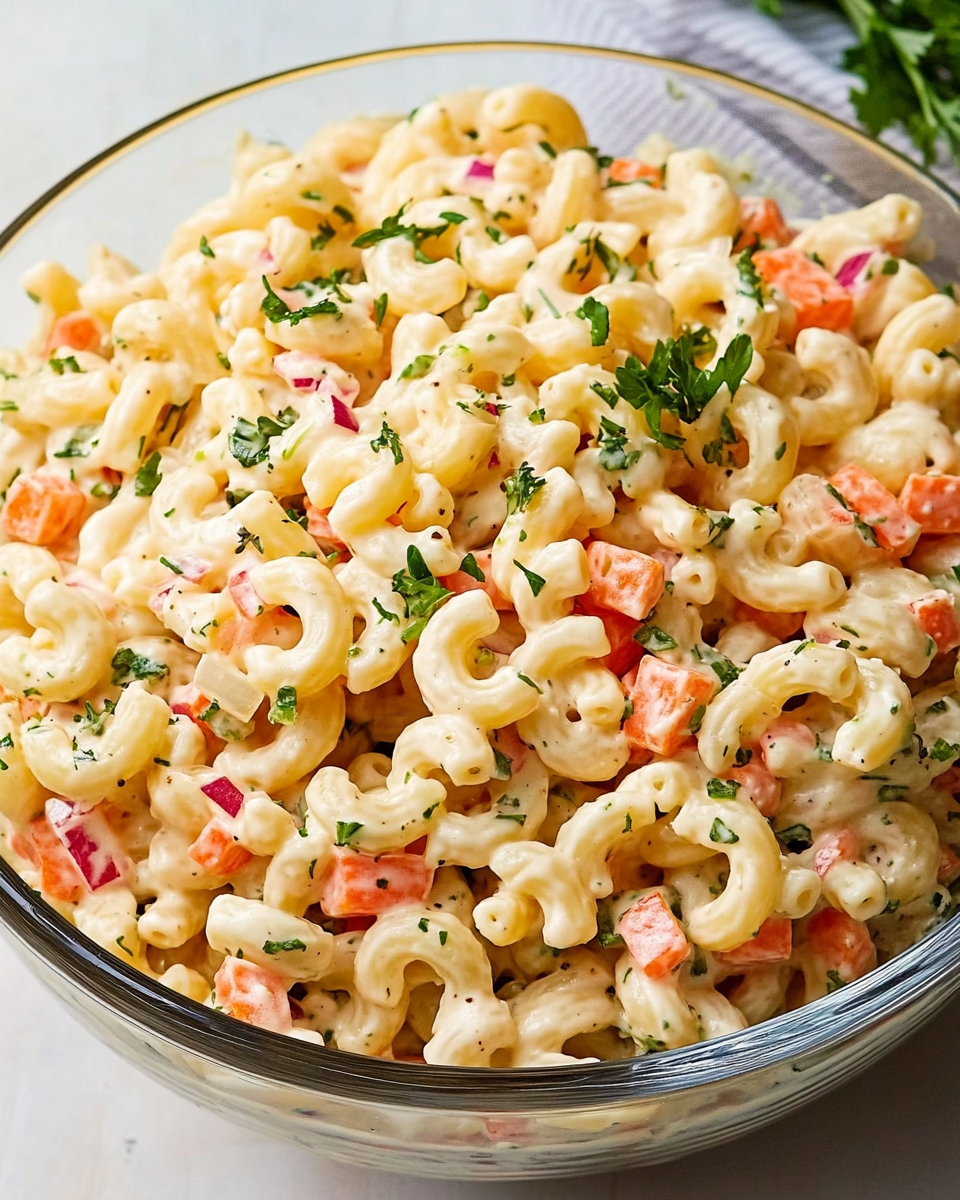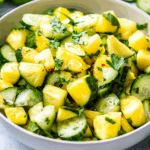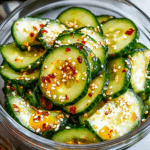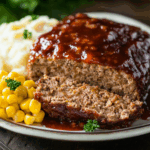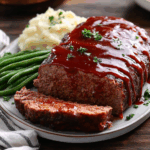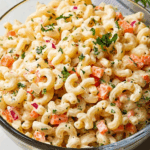This creamy, tangy, and flavor-packed macaroni salad takes a cue from the classic comfort food joints featured on Diners, Drive-Ins & Dives. It’s the perfect make-ahead side dish that pairs beautifully with grilled meats, fried chicken, or a hearty BBQ spread. Loaded with crunchy vegetables and a zesty dressing, this macaroni salad delivers nostalgia and flavor in every bite.
FULL RECIPE
Ingredients
- 2 cups elbow macaroni, uncooked
- 1 cup mayonnaise
- 2 tablespoons Dijon mustard
- 2 tablespoons apple cider vinegar
- 1 tablespoon sugar
- ½ teaspoon salt
- ½ teaspoon black pepper
- 1 teaspoon garlic powder
- 1 cup celery, finely chopped
- ½ cup red bell pepper, finely chopped
- ½ cup red onion, finely chopped
- ¼ cup sweet pickle relish
- 2 hard-boiled eggs, chopped (optional for added richness)
- 2 tablespoons chopped fresh parsley (optional for garnish)
Directions
- Bring a large pot of salted water to a boil. Add elbow macaroni and cook until al dente, about 7–8 minutes. Drain and rinse with cold water to cool.
- In a large mixing bowl, combine mayonnaise, Dijon mustard, apple cider vinegar, sugar, salt, pepper, and garlic powder. Whisk until well blended.
- Add the cooled macaroni, celery, bell pepper, onion, and relish to the bowl. Toss until everything is evenly coated.
- Fold in chopped hard-boiled eggs if using.
- Cover and refrigerate for at least 2 hours before serving to let flavors meld.
- Garnish with parsley before serving if desired. Serve chilled.
Nutrition Facts
- Calories: 320
- Total Fat: 22g
- Saturated Fat: 3.5g
- Cholesterol: 65mg
- Sodium: 450mg
- Total Carbohydrates: 25g
- Dietary Fiber: 1g
- Sugars: 4g
- Protein: 5g
- Vitamin A: 10% DV
- Vitamin C: 15% DV
- Calcium: 2% DV
- Iron: 6% DV
History and Origins of Macaroni Salad
Macaroni salad has its roots in European pasta salads but became widely popularized in the United States during the 20th century, especially in diners and family-style restaurants. It evolved as a convenient, creamy, cold side dish perfect for picnics, barbecues, and potlucks. The salad is traditionally made with elbow macaroni, mayonnaise, and a variety of vegetables, making it an accessible and versatile dish for many occasions. Its association with comfort food and casual dining has helped it endure as a beloved staple in American cuisine.
The Role of Texture in Macaroni Salad
One of the most important factors that make macaroni salad enjoyable is its texture. The tender yet slightly firm macaroni provides a satisfying bite, while the crisp vegetables such as celery, bell pepper, and onion add a refreshing crunch. The creamy dressing binds the ingredients together without overwhelming the salad, creating a balanced mouthfeel. Achieving the right texture contrast is crucial for a macaroni salad that keeps diners coming back for more.
Flavor Profile and Balance
This macaroni salad achieves a harmonious balance of flavors—creamy, tangy, sweet, and savory. The mayonnaise base offers richness, while Dijon mustard and apple cider vinegar add a pleasant tang that cuts through the creaminess. A touch of sugar softens the acidity and rounds out the taste. The fresh vegetables contribute mild bitterness and sweetness, creating a layered flavor experience that is complex yet familiar.
Nutritional Considerations
While macaroni salad is delicious, it’s also important to consider its nutritional content. This recipe is relatively high in calories and fat due to the mayonnaise, but it also provides a modest amount of protein and fiber from the vegetables and pasta. For those watching their intake, substitutions like light mayonnaise or yogurt can be used to reduce fat and calories. Adding more vegetables can also increase fiber and micronutrients, making the salad more balanced nutritionally.
Variations Across Cultures
Macaroni salad is not limited to one cultural interpretation. Different regions and cultures have put their spin on it, incorporating unique ingredients like olives, boiled eggs, cheese, or even seafood. Some recipes use vinaigrette instead of mayonnaise for a lighter version, while others add curry powder or paprika for an extra kick. This adaptability makes macaroni salad a truly global dish that can be tailored to personal tastes or dietary needs.
Ideal Occasions for Serving
Macaroni salad shines as a side dish during warm-weather gatherings, such as barbecues, picnics, and potlucks. Its ability to be prepared ahead of time and served cold makes it convenient for hosts and a refreshing complement to grilled or fried foods. It also works well in lunchboxes or casual weeknight dinners, providing a comforting and familiar option that is quick and easy to serve.
Pairing Suggestions
This creamy macaroni salad pairs exceptionally well with hearty main dishes. It complements smoky grilled meats, crispy fried chicken, and spicy barbecue perfectly by providing a cool, creamy contrast. It also pairs well with sandwiches, burgers, and wraps, adding texture and flavor to the meal. For a vegetarian pairing, it can be served alongside grilled vegetables or a fresh green salad to round out the plate.
Tips for Preparing the Perfect Macaroni Salad
Achieving the best macaroni salad requires a few key tips. First, cook the pasta just until al dente to avoid a mushy texture. Rinsing the pasta under cold water immediately after cooking stops the cooking process and cools it down quickly. Using fresh, crisp vegetables adds vital crunch, while chilling the salad for at least a couple of hours allows the flavors to meld and intensify. Finally, seasoning to taste before serving ensures every bite is flavorful.
Storage and Shelf Life
Macaroni salad is best served chilled and can be stored safely in the refrigerator for up to 3-4 days. Because it contains mayonnaise and fresh vegetables, it’s important to keep it properly covered and refrigerated to maintain freshness and prevent spoilage. Stirring the salad occasionally during storage helps redistribute the dressing and keep the flavors consistent throughout.
Healthier Ingredient Swaps
For those looking to lighten up their macaroni salad without sacrificing taste, several ingredient swaps can be made. Using Greek yogurt or a mixture of yogurt and mayonnaise reduces fat while maintaining creaminess. Whole wheat or chickpea pasta can add fiber and protein. Increasing the amount of fresh vegetables or adding leafy greens can boost the nutrient content. Additionally, reducing or omitting sugar and salt helps lower overall sodium and added sugars.
The Science Behind Emulsification in the Dressing
The creamy texture of macaroni salad dressing is due to emulsification, a process where oil and water components are combined with the help of an emulsifier—in this case, mayonnaise. The mustard acts as an additional emulsifier, stabilizing the mixture and preventing separation. This chemical process creates a smooth, thick dressing that clings beautifully to the pasta and vegetables, enhancing both texture and flavor.
Macaroni Salad in Popular Culture
Macaroni salad is often featured in American pop culture as a nostalgic comfort food symbolizing family gatherings, picnics, and summer holidays. It’s a frequent contestant in food competitions and cooking shows, highlighting its enduring popularity and versatility. Diners, Drive-Ins & Dives and similar programs have helped elevate this humble dish, introducing it to new generations and inspiring countless recipe variations.
Conclusion
Diners, Drive-Ins & Dives inspired macaroni salad is more than just a side dish; it’s a celebration of flavor, texture, and culinary tradition. Its rich history, adaptability, and satisfying taste make it a crowd-pleaser for any occasion. Whether served at a backyard barbecue or a casual family dinner, this macaroni salad brings comfort and nostalgia to the table, while still offering room for creativity and customization. Perfectly balanced and easy to prepare, it’s no wonder this salad continues to hold a special place in American food culture.

